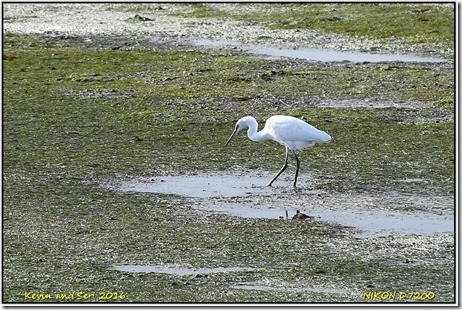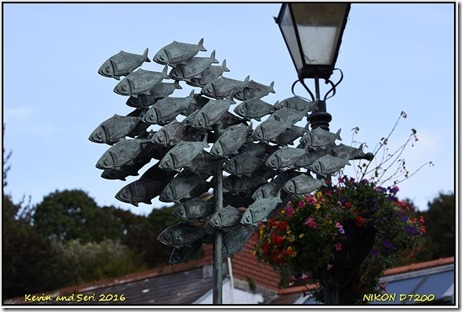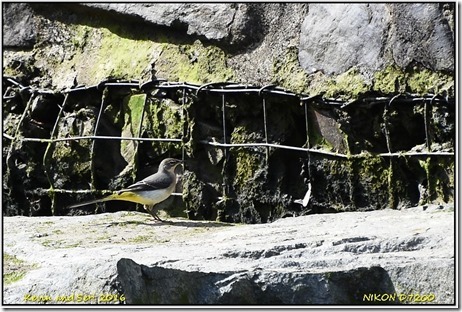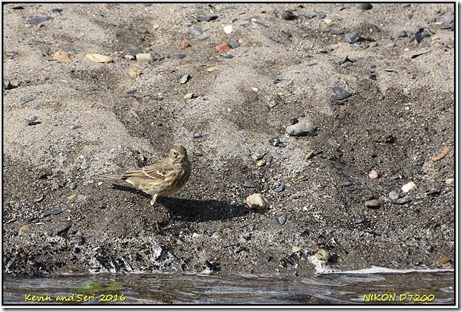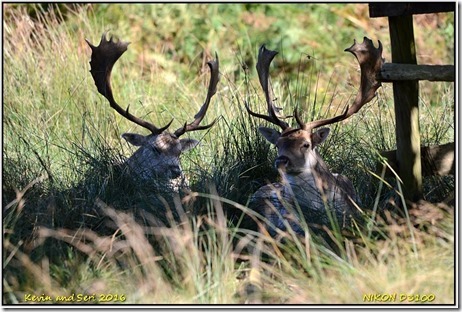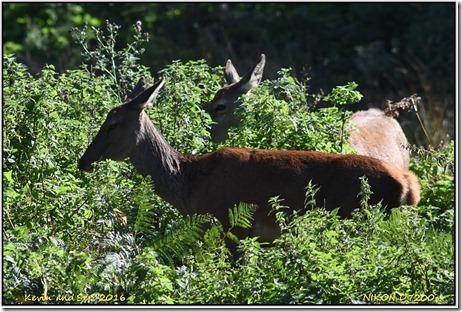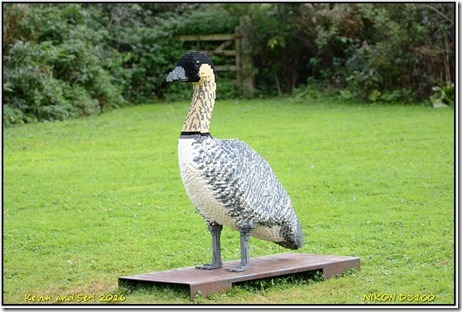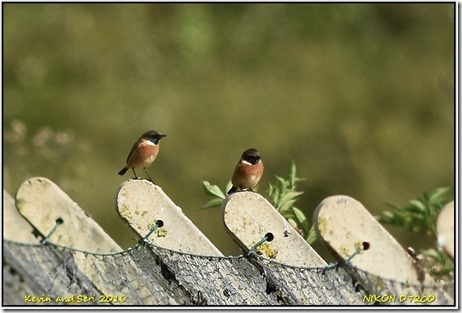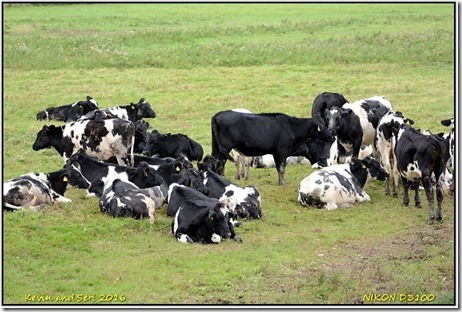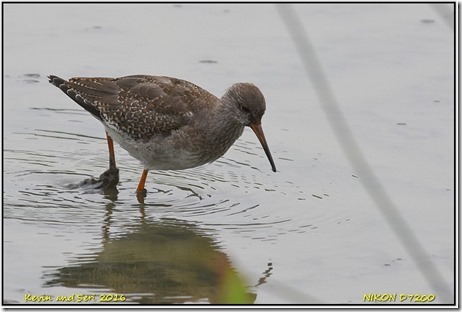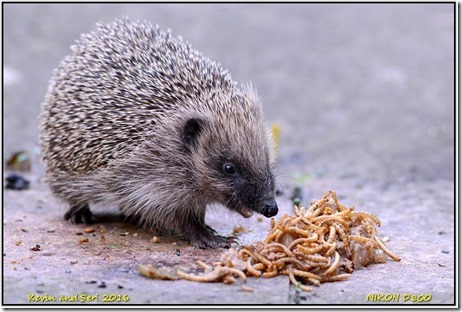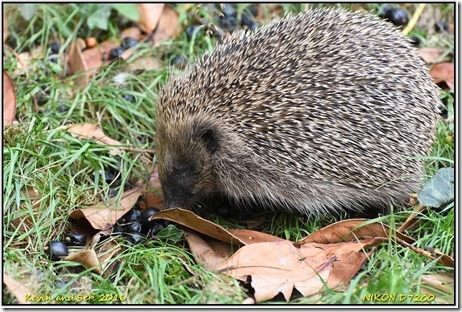Though we've got to say
Goodbye for the summer
Baby, I promise you this
I'll send you all my love
Every day in a letter
Sealed with a kiss
Yes, it's gonna be a
Cold, lonely summer
But I'll fill the emptiness
I'll send you all my dreams
Every day in a letter
Sealed with a kiss
I'll see you in the sunlight
I'll hear your voice everywhere
I'll run to tenderly hold you
But baby, you won't be there
I don't wanna say
Goodbye for the summer
Knowing the love we'll miss
So, let us make a pledge
To meet in September
And seal it with a kiss
Yes, it's gonna be a
Cold, lonely summer
But I'll fill the emptiness
I'll send you all my love
Every day in a letter
Sealed with a kiss
♫ Bobby Vinton♫
Babe’s beautiful niece got married to her partner in Haverfordwest, Pembrokeshire in the middle of the month. I took 2 days of work so that we were there for their auspicious day. We left the casa at 9.53 am and it was cloudy with a light drizzle. There was quite a lot of traffic and made travelling slower with 50 mph speed limit due to road works.Thankfully, we were able to make up time when we exited at junction 8 on the M50 towards Ross-On-Wye.
We by-passed Ross-On-Wye which was a shame and was on the A40 which took us all the way to Carmarthen. It was the first day of Autumn but the countryside was still green. We made a pit stop at a newly-opened Monmouth services and drove through Newport, Cardiff, Bridgend and only from Carmarthenshire onwards we noticed that the road-signs were bilingual. The clouds opened and we’d alternating sunshine.
Since we were early, we headed straight to Pembrokeshire Castle to stretch our legs. We parked our car under the imposing shadow of the medieval castle. Norman Lord, Roger of Montgomery founded the first castle, made from earth and wood in the 11th century, during the Norman invasion of Wales. A century later, it was given to William Marshall, 1st Earl of Pembroke, by Richard 1. Marshall, was one of the most powerful men in 12th century Britain, rebuilt the castle in stone creating most of the structure seen today.
Pembroke Castle was the only castle in Britain to be built over a natural cavern, a large cave known as the Wogan. Historically, it was important not only for its masonry but but because Harri Tudur, who became Henry VII and inaugurated the Tudor line of monarchs, was born here in 1457 reputedly in the tower now known as the Henry VII Tower.
During the troubled reign of King Charles, the castle was attacked in turn by both Royalist and by Roundheads as the sympathies of its occupant altered. In the later stages of the struggle an attacking force was led by Cromwell who ordered the castle to be destroyed. The townspeople were encouraged to disassemble the fortress and re-use its stone for their own purpose.
We didn’t check the castle cos you’ll need a few hours to wander around. Instead we walked around the northern line of the castle medieval walls which was now the Castle-pond Walk. We strolled alongside the River Cleddau on a broad mix of tarmac minor road, lanes and path plus gravel paths and wooden walkways. We walked to Mill Bridge that crossed the Mill Pond, which was formerly a tidal inlet that defended the town and castle on their northern flank.
We stopped on the bridge and there were a few wading birds feeding on the mud sediments. There were herons, redshanks, little egret and off course gulls. I would love to walk further but it was time to get back and check into our rooms. It was relaxing to walk around this incredible historic building. Pembroke Castle was one of the most breath-taking buildings I’d ever seen and to think that it had been around since 1093, made it even more impressive. One day, I hoped to check this spectacular castle and walked further, all along the Millpond trail.
We checked in at the Travel Lodge and freshened up. We’d our sandwiches for lunch and had a rest. I called my mother-in-law but she didn’t answer the telephone. Then we went for a walk to the pier for some fresh air. From here, we could see this magnificent structure looming over us. The Cleddau Bridge, a toll bridge on the A47 that spanned the River Cleddau between Neyland and Pembroke Dock was opened to public on 20th March 1975 and It cost 75 p for cars to drive through.
From here, we continued to the dock yard. The tide had gone and the muddy banks was exposed. We were delighted to see a few Redshanks and a little Egret feeding among the Gulls. The Redshanks with their bright orange-red legs and broad white trailing edge to the wings were prominent in flight. The flight ‘song’ of sweet-yodelling notes trailed as they flew from one end to another. The Little Egret stood out well in its pure white plumage among the bleakness.
“Wading birds respect each other’s territory’”
~Alvin May~
We looked around the dockyard which was covered with silt and littered with abandoned shopping trolleys and ship carcasses. The town of Pembroke Dock was founded in 1814 when the Royal Navy Dockyard was established. Nearly 300 ships were built in the yards. And on 2nd September 1925, it was announced that it was to close. What a devastating blow to a town that came into being as a result of the Dockyard’s existence. It took years to improve the town’s image in respect of its reputation for high unemployment and industrial decline.
I called my mother-in-law again and this time she picked up the phone. We nipped over at her place for a chat and gossips. It was lovely seeing her again. Then we walked back to Travel Lodge making a pit stop at Asda for bits and bops. We’d dinner and then an early night. It was going to be a very long day tomorrow.
We were the first to arrive at the registry in Haverfordwest and made ourselves comfortable. Then slowly, the relatives and friends started to trickle in. It was lovely seeing everyone again. The last time we met was in September last year at SA wedding in Worcester. About half an hour later, the bride and groom arrived with their 2 adorable young sons. We thought they’d eloped![]()

After a few introductions and instructions from the registrar, we were all seated in the wedding room. The handsome groom and his best man waited patiently for the radiant bride to walk through the door with her proud father. A beautiful song accompanied the walk and then the ceremony began. It was very short and simple and finally they were pronounced as man and wife. The groom’s mother was crying her eyes out. I bet TA too would be the same. We met the couple for a hug and to wish them all the very best.

We didn’t stay for the reception lunch because we’d about 5 hours drive home. After showering the newly-weds with confetti and saying our goodbyes to the rest of the tribe, we went our separate ways. We decided to take the scenic but longer coastal route home. It was lovely to be back driving through these tiny quaint villages, coastal towns and winding roads. The last time we were here was when we said goodbye to TA, about 10 years ago.

We detoured up to the Preseli Hills which rose out of the landscape at 536m. The landscape was wild moorland, heath and grassland. We parked near Foel Eryr and walked for a bit to check the breath-taking views of the surrounding landscapes of natural cliffs and crags. Sheep dotted the hillsides. It was quite strange to find out that Stonehenge was built from the rocks around here. We didn’t stay long cos it was so windy and it was also freezing.

Then we drove down again and made a pit stop at Lower Fishguard., a picturesque village with its cluster of quayside cottages and tidal inner harbour. Locally known as Lower Town, it was situated in a deep valley where the River Gwaun met the sea. It was a typical fishing village with a small fleet catching pilchards and herring. This sculpture of a shoal of herring darting through the air was a reminder of the historic importance of the catch to the economy of this place.
We wandered around this quaint cul-de-sac which was the scene for the filming of Dylan Thomas’ Under Milkwood, with Elizabeth Taylor and Richard Burton in 1972. This tiny close-knit town was transformed into the fictional Llareggub (‘bugger all’ spelt backwards) dreamed up by the poet decades before. Lower Fishguard’s chocolate box streets might had been lifted off the pages of Dylan’s work with scenes filmed in front rooms and kitchens of the houses along the Quayside. But we were more interested in this adorable Grey wagtail which was frantically bobbing, ducking and dashing about.
In 1779, Lower Fishguard was raided by the privateer Black Prince, which bombarded the town when the payment of a £1,000 ransom was refused. As a result, Fishguard Fort was completed in 1781, overlooking the port. The area was also the site of the last unsuccessful invasion of Britain when a force of 1,400 French soldiers landed but surrendered 2 days later at the Battle of Fishguard in 1797. Quite a lot of history for such a tiny hamlet. While we gathered our thoughts, this Rock Pipit flew close to where we were standing, utterly unfazed by our presence.
Then we drove to the end of the harbour and parked beside this sculpture by the artist, John Cleal, a South African emigre who made his home here in the early 1960’s. He also did the above sculpture of the herrings titled ‘Sgadan Abergwaun’. Since his death in 2007, his family had carried out his wish to have this sculpture ‘Sun Lover’ sited here in recognition of his great affection for the area where he lived for more than 40 years. Then it was time to hit the road again.
We detoured again and spent a few hours in New Quay, a very popular picturesque seaside town on the Cardigan Bay coast. We knew parking was going to be a nightmare but somehow we managed to find a space at one of the private parking sites. It was still buzzing even in late September and in the late afternoon. The blue flag awarded golden sandy beaches that extended in a golden arch around the sheltered bay was gleaming in the evening sun, ideal for relaxing and strolling.
We headed straight to the pier walking past an array of gift shops, cafes, pubs and restaurants that lined the pretty narrow streets. We were hoping to spot the bottle-nosed dolphins and grey seals which made Cardigan Bay their home. We asked a couple of surveyors from the Cardigan Bay Marine Wildlife Centre whether they’d seen any. They had seen a mother and pup in the morning and that was it. There were boat trips taking visitors around the spectacular Ceredigion Marine Heritage Coast but I think they too didn’t spot any dolphins.
We stayed for nearly an hour soaking up the late sun and the very laid-back atmosphere, listening to the very boisterous gulls. We spotted the old warehouses, now put to new uses, lengths of chains, metal rings and capstans, and a list of tolls for export and imports outside the harbourmaster office. Then it was time to head the road again but not before sharing a large box of freshly cooked double-dipped chips. Sitting in the car with a bay view while tucking into piping hot-fresh chips was one of life’s great pleasures.
New Quay had a strong link with Dylan Thomas, who wintered here in 1944-45 when he composed ‘Quite Early One Morning’. The town was often cited as the inspiration for the fictitious village of Llareggub (see Lower Fishguard), the ‘cliff-perched town at the far end of Wales’ in his famous work ‘Under Milk Wood’. The feature film The Edge of Love (2008) about his life, was filmed locally starring Kiera Knightley, Sierra Miller and Matthew Rhys as the man himself.
We had to stop on the hill overlooking the tiny village of Llanon, where we lived happily for nearly 8 years in a tiny stone cottage with an amazing fireplace. The village was named after the church of Saint Non, the mother of Saint David. We wondered whether our neighbours were still around? It would be bittersweet to find out. But we continued on to Aberystwyth. At first, we planned to stop but changed our minds and headed home.
As usual, after the long trip back from Wales, the next day we stretched our legs at Bradgate Park. The main car-park was full but we managed to find a parking space as a car was driving out. When we walked through the gates, the Fallow deer were still chilling out under the shade, ruminating while chewing cud, watching the visitors checking them out. They were still tolerating each other. A few were feeding on the acorns that fallen onto the ground.
We crept closer to another group that were feeding near the River Lin. These guys were enjoying some pampering from the Jackdaws that were brave enough to get close. The deer was sitting still with enjoyment evident in each line of its body as the Jackdaw explored for ticks. There were several spinneys of woodland ( pine and mixed deciduous) that provided secluded nesting areas for a large colony of rooks and jackdaws.
We heard the familiar whistling call ‘wheeoo’ from our favourite Wigeon. He was looking a bit battered, just after moulting, when the plumage was said to be in ‘eclipse’. He was busy chasing off the other ducks as they scrambled over the pieces of bread that was thrown by the visitors. This time he wasn’t alone. This hybrid was spotted among the mallards.
We noticed a female Red deer feeding among the bracken and followed her as she made her way through the woods with her herd of hinds, together with their calves and other young that were born the previous year. We lost sight of them as they disappear deeper into the woods. We heard the hinds barking and mooing for their young. while the calves emitted a high-pitched squeal and bleated for their mother.
We headed straight to the main field, where a male Fallow deer was sniffing around the ladies. Bucks often created rutting stands in traditional areas to which the does were attracted. Alternatively bucks searched out doe groups and mate opportunistically. This mature buck had a very prominent Adam’s apple and a very obvious brush of hair under its belly. But the ladies weren’t ready and kept running away from him. He vented his frustration towards the nearby bushes and bracken, before lying down for a rest.
In a well-known 16th century English folk ballad ’The Three Ravens’, the term ‘fallow doe’ was used metaphorically, meant ‘a young woman’.
Down there comes a fallow doe,
As great as young as she might goe,
We wanted to check out Bradgate House ruins but it was locked. So we headed back to the car as more and more visitors were piling in. There were quite a large group of school children with rucksacks undergoing an orienteering course. We also came across a few toadstools that were popping up here and there. The wet summer and mild autumn had made it a bumper year for fungi although the ones we see here were mostly eaten by the deer or trampled by people walking.
We also checked out Slimbridge. There were quite a few families about with young children taking part in a LEGO hunt. There were eleven individually designed 1.5 m LEGO brick animals, inspired by their real –life cousins found here. These awesome models formed a trail for kids (and big kids) to inspire them to build a better future for nature. They were a fun way to highlight some of the animals WWT helped to protect, such as the iconic Bewick’s swans represented by Benedict stretching his brick wings and the 6 species of flamingo, in the shape of Flavia, the Andean flamingo with its riot of pink bricks.
In total 91700 bricks were used over 955 hours to make all the characters. Lottie the Otter and Bruce the red breasted goose took the longest time to make at 120 hours each. Lottie below was named through a social media competition, to celebrate the birth of Princess Charlotte. We spotted a few here and there as we wandered about in the grounds.
As usual. we headed to Rushy Hide first but it was closed because there were work being done. They were clearing the undergrowth surrounding the lake with big machines. I wasn’t impressed because firstly, they should mentioned it on their home page and secondly, it was nearing winter and there will be insects etc hibernating!!! I thought they would be aware of this. We headed straight to the empty Martin Smith Hide and immediately spotted a handsome Stonechat sitting on the top of the gorse bushes opposite the hide.
These Robin sized birds were frequently seen flicking their wings while perching. We spotted the handsome male first with his striking black heads with white around the side of his neck, orange red breasts and a mottled brown back. He kept on flying low into the bushes, and as insectivorous, were picking caterpillars, ants, spiders and flies that lived there. In autumn and winter, they fed on seeds and berries.
It flew to the stone post where a female was waiting. She lacked the male’s black head, but had brown back and an orange tinge to their chests. They must had some conversations and as their name suggested, uttering sharp loud calls that sounded like two stones being tapped together. What a pity we were too far away to hear.
We also spotted a huge flock of Goldfinches busy feeding on the thistles at the bottom of the field. They were brightly coloured finch with red faces and yellow wing patches. They were busy extracting the seeds from thistles and teasels using their fine. long beaks. When they flew off and pass over the hide, their delightful liquid melodic bubbling chatters could be heard. The collective noun for a flock of Goldfinches was a charm and it suited these delightful little birds perfectly.
We continued on and checked the rest of the hides. Unfortunately, they were empty both of people and birds. Where were everybody? The waders might be feeding on the mudflats of the nearby River Severn. There were a herd of cattle feeding on the tack field. They played a key role in maintaining species-rich habitats by controlling more aggressive species which would dominate these areas and by preventing scrub encroachment.
We then walked back into the grounds spotting more LEGOS. We made a pit stop at Zeiss Hide because a sighting of a Bittern had been reported. The explosive calls of a Cetti Warbler erupted from the reed-beds. I strained my eyes to find it but this bird was very elusive. Thankfully, the large herd of Old English Longhorn kept our cameras busy. The impressive sweep of horns that curved down to around their noses s made them appeared aggressive but they were noted for their exceptional docility.
Then we headed to Hogwarth Hide walking past another brick LEGO bird.. This time it was a Mallard. We spent quite a long time here because there were plenty of waders keeping us occupied. Closest feeding to the hide were the Redshanks with their long, reddy orange legs and also reddy-coloured lengthy, straight bills. Then in typically fast erratic flight, a few flew in with their agitated, far-carrying cries ‘tlu-leu-leu.
Redshanks were once known as ‘yelpers of the marsh’, for the slightest hint of provocation brought the same. noisy, babbling response. We watched them wading in the shallow waters, regularly pecking, jabbing and sweeping through the water with their bill. Outside the breeding season, they fed on molluscs, crustaceans, small fishes and tadpoles.They foraged in flocks for better protection and safety especially in open areas.
Ruffs in their plain grayish brown winter colours were also busy feeding. In freshwater, they were often seen wading up to their bellies. They walked or ran at a steady pace with their heads up, feeding on the mud-dwelling invertebrates. They sometimes probed in the mud and walked slowly through the vegetation with their heads down.
Then we’d the challenge of counting the very well camouflaged Common Snipes, concealing themselves close to the ground vegetation. We spotted a few foraging in the soft mud, probing or picking insects and earthworms up by sight. When flushed, they uttered a sharp note that sounded like scape, scape and flew off in a series of aerial zig-zags. Their old folk names included ‘mire snipe’, ‘horse gowk’. ‘heather bleat’ and the variant spelling ‘snite’.
Then it was time to head back into the main area. While waiting for the Otter talk to commence, I checked some of the mammals at the Back from the Brink Area which included water voles, shrews, beavers and harvest mice. They were housed in glass-like homes and it was a challenge to see them. I was chuffed when I spotted this tiny harvest mouse having a wash. It was also quite difficult to photograph them as light was reflected back from the glass panels.
Then it was time to watch the Otters. Babe took his position near the concrete wall. We’d seen this playful family of North American river otters countless times and always enjoyed the commentated feeding sessions. I think I could recite them by now. Mother Flo, and twins Minnie and Ha Ha arrived in summer 2009as part of the wetland mammal area. Since then, it had been a tough life for them who spent their days frolicking in the water, sunbathing, feeding, posing and sleeping in their den.
Our last destination was the South Lake Discovery Hide. The world’s rarest goose, the Nene, were wandering about waiting to be fed. We got the evil eye when they saw us empty-handed. When we looked out of the hide, we spotted a flock of Black-tailed Godwits about to fly off. They were in their winter colours, with grey above and white below. In flight, they displayed a broad white bar on the wings, a white rump and a black tail with their characteristic weeka-weeka-weeka calls.
At work, one of my colleagues organised a Macmillan Cake day to raise funds for the Macmillan Cancer Support. All the talented bakers in the library got stuck in, bringing in their yummy home-baked cakes. Those who didn’t bake donated generously by buying them. Raising money for Macmillan helped the charity to provide medical, emotional, practical and financial support for people with cancer, whilst campaigning for better cancer care. Nearly £300 was collected. That was a lot of cakes. Well-done to HH for organising it.
One of our favourite activities for this month was feeding the hedgehogs in the evening. We loved all of them but we have a favourite we named Nelson. When we first met him, he was a skinny little tyke, all bones and prickles. We were a bit worried when we found him wandering up and down the garden, in broad daylight. This was because if you saw a hedgehog out in daylight, it was a sign of sickness. But, he walked straight to the steps where we put the food in the evenings and started sniffing around. I quickly put some mealworms and he scoffed it down. He was feeding ok. And then, he squeezed through the fence and wandered off.
“If wits were pins, the man would be a veritable hedgehog’
~Frances Hardinge~
Babe took hundreds of photographs and when he went through them, he realised that he was blind. That was why Babe named him Nelson after Admiral Lord Nelson who lost the sight in his right eye at the Seige of Calvi in Corsica in 1794. Perhaps that was why, he was turning up early for the feed so that he had an advantage against the others. There might be at least half a dozen hedgehogs coming in to feed through the night. We fed them on mealworms and mashed dog-food. The cats in the neighbourhood heard about the party and started sneaking in. The party, occasionally, brought a very handsome young fox .
‘The fox knows many things; the hedgehog one big one.’
~Archlochus~
Nelson turned up every night as early as 6.30 pm. He snacked on a handful of mealworms. I could hear the crunching as he devoured his meal. I knew it was him because of the way he eats. He tended to hunker down very close to the ground, with his blind side facing the door. He ate every worm before having a drink from the bird-bath which was the cutest thing I’d ever seen.
‘Beautiful things should belong to beautiful souls.’
~Muriel Barberry, ‘The Elegance of the Hedgehog’~
Then he would wander away, checking out the neighbourhood. I would then put the mashed dog-food and more mealworms out. An hour later, he would return to have his dinner. We weight him once to make sure that he’d enough body fat to see him through hibernation. He was more than 600 grams which was more than the minimum weight. Fingers-crossed, at the rate he was eating, he will be at least a kilo before he goes into a long sleep when winter approaches.
“Ah, September! You are the doorway to the season that awakens my soul … but I must confess that I love you only because you are a prelude to my beloved October.”
~Peggy Toney Horton~











